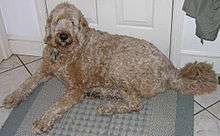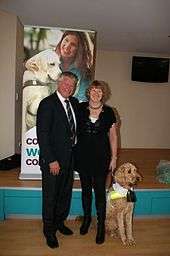Labradoodle
 A brown Labradoodle with a fleece type coat. The appearance of Labradoodles may vary. | |
| Foundation stock | Labrador Retriever, poodle |
|---|---|
| Variety status | Not recognized as a standardized breed by any major kennel club. |
| Domestic dog (Canis lupus familiaris) | |
A labradoodle (/ˈlæbrəˌduːdəl/) is a crossbreed dog created by crossing the Labrador Retriever and the Standard, Miniature or Toy Poodle. The term first appeared in 1955, but was not popularized until 1988, when the mix began to be used as a hypoallergenic guide dog. Currently, they are not considered a breed by any major fancier and breeder organization. Not all labradoodles are hypoallergenic, but it is a quality that many look for and appreciate in this type of crossbreed.
History
The labradoodle became known in 1988, when Australian breeder Wally Conron crossed the Labrador Retriever and Standard Poodle at the Royal Guide Dogs Associations of Australia in Victoria.[1]
Conron's aim was to combine the low-shedding coat of the poodle with the gentleness and trainability of a Labrador retriever, and to provide a guide dog suitable for people with allergies to fur and dander.[2][3] Sultan, a dog from this litter, displayed all the qualities Conron was seeking and worked as a guide dog for a woman in Hawaii for ten years.[2]
Although Guide Dogs Victoria no longer breed labradoodles,[2] they are bred by other guide and assistance dog organizations in Australia and other places.[4] The Association for the Blind of Western Australia has introduced labradoodles into their training program, and their first, Jonnie, graduated in November 2010.[5][6] Labradoodles are now widely used around the world as guide, assistance, and therapy dogs[7][8] as well as being popular family dogs.[2]
The Norwegian crown prince and princess own labradoodle.[9][10]
Conron has since repeatedly stated he regrets initiating the fashion for this type of crossbreed and maintains it caused "a lot of damage" together with "a lot of problems". He also felt he was to blame for "creating a Frankenstein", adding that problems were being bred into the dogs rather than breeding away from problems. He is further quoted as claiming: "For every perfect one, you're going to find a lot of crazy ones."[11]
Appearance and temperament

Because the labradoodle is a crossbreed and not a breed, puppies do not have consistently predictable characteristics.[2] While most labradoodles have some common traits, their appearance and behavioral characteristics remain, to some extent, unpredictable.[2] As such, labradoodles' hair can be anywhere from wiry to soft, and may be straight, wavy, or curly.[2] Straight-coated labradoodles are said to have "hair" coats, wavy-coated dogs have "fleece" coats, and curly-coated dogs have "wool" coats.[2] Many Labradoodles do shed, although the coat usually sheds less and has less "dog odor" than that of a Labrador Retriever.[2]
Like most Labrador Retrievers and poodles, labradoodles are generally friendly, energetic and good with families and children.[2] Labradoodles often display an affinity for water and strong swimming ability from their parent breeds.[2]
Their parent breeds are both amongst the world's most intelligent dog breeds, in which the poodle is believed to be the smartest (only aside from the border collie).[12]
Types

There is no consensus as to whether breeders should aim to have labradoodles recognized as a breed. Some breeders prefer to restrict breeding to produce F1 hybrids (bred from a poodle and Labrador rather than, e.g. F2 hybrids bred from two labradoodles) to ensure relatively uniform genetics among the labradoodles, while maximizing genetic diversity of individual dogs to avoid inherited health problems that have plagued some inbred dog breeds.

Others are breeding labradoodle to labradoodle over successive generations, and trying to establish a new dog breed. These dogs are usually referred to as multigenerational (multigen) or Australian Labradoodles.[2][13] Australian Labradoodles also differ from early-generation and multigenerational labradoodles in that they may also have other breeds in their ancestry. English and American Cocker Spaniel × poodle crosses (i.e. cockapoos), Two Irish Water Spaniels and Soft-Coated Wheaten Terriers were used in some Australian Labradoodle lines. The Curly Coated Retriever were used too, but these lines did not work out and these breeds were no longer used.[14]
Labradoodle coats are divided into three categories: wool (with tight curls, and similar in appearance to that of a poodle, but with a softer texture); fleece (soft and free-flowing, with a kinked or wavy appearance); or hair (which can be curly, straight or wavy, but is more similar in texture to a Labrador's coat).[2] Labradoodles' coat colors include chocolate, cafe, parchment, cream, gold, apricot, red, black, silver, chalk, parti colours[15] (i.e. generally, any color a poodle can have). They can be different sizes, depending on the size of poodle used (i.e. toy, miniature, or standard).[2]
Health
Labradoodles can suffer from problems common to their parent breeds. Poodles and Labrador Retrievers can suffer from hip dysplasia, and should have specialist radiography to check for this problem before breeding. The parent breeds can also suffer from a number of eye disorders, and an examination by a qualified veterinary eye specialist should be performed on breeding dogs.
Labradoodles have been known to suffer from progressive retinal atrophy (PRA), an inherited disease causing blindness, which occurs in both Miniature Poodles and Cocker Spaniels. It is recommended that Australian Labradoodles be DNA tested for PRA before being bred.
One study has found that UK labradoodles have a higher incidence (4.6%) of multifocal retinal dysplasia (MRA) compared to Labrador Retrievers. Cataract is common as well (3.7%) but prevalence is comparable to that of Labradors.[16]
There is evidence of some occurrence of Addison's disease in the Australian Labradoodle.[17][18] The Australian Labradoodle Association of America is currently conducting a study to try to determine how widespread the problem has become.
References
- ↑ Conron, Wally. "My Story: I Designed a Dog", Reader's Digest, 10 July 2007.
- 1 2 3 4 5 6 7 8 9 10 11 12 13 14 Hot Dogs!. Barron's. 2007. pp. 20–29. ISBN 0-7641-3512-0.
- ↑ Staff (2008-01-01). "Labradoodle". Animal World. Archived from the original on 13 December 2012. Retrieved 2008-10-16.
- ↑ A Guide Dog with a difference. Association for the Blind of WA – Guide Dogs WA (2010-09-07)
- ↑ Busselton Guide Dog Graduation – Association for the Blind of Western Australia. Guidedogswa.com.au. Retrieved on 2012-12-18.
- ↑ New dog in town. Association for the Blind of WA – Guide Dogs WA (2010-09-02)
- ↑ Colchester: More than puppy love! (From Gazette). Gazette-news.co.uk (2008-06-17). Retrieved on 2012-12-18.
- ↑ Altonn, Helen. (2004-06-28) Honolulu Star-Bulletin Hawaii News. Starbulletin.com. Retrieved on 2012-12-18.
- ↑ "Her er kronprinsparets nye kjæledegge" (in Norwegian).
When it became known that the Crown Prince couple's new dog would be a so-called "labradoodle" there was no lack of critical voices.
- ↑ Krupnick, Ellie (17 May 2012). "PHOTOS: Norway's Royal Family Gets Decked Out For Norwegian Constitution Day". Huffington Post.
- ↑ "Inventor of the Labradoodle speaks out". Our Dogs Publishing. 14 February 2014. Archived from the original on 13 February 2014. Retrieved 13 February 2014.
- ↑ Coren, John (1994). New York Free Press, ed. The Intelligence of Dogs. New York, NY: New York Free Press. Retrieved 2008-10-16.
- ↑ "The Australian Labradoodle". Goldendoodles.com. Retrieved 2011-01-02.
- ↑ "FAQ: Australian Labradoodles". Goldendoodles.com. Retrieved 2011-01-02.
- ↑ "IALA Breed Standard (1997 revised 2007)". International Australian Labradoodle Association. Archived from the original on 24 October 2012.
- ↑ Oliver, J. A. C.; Gould, D. J. (2012). "Survey of ophthalmic abnormalities in the labradoodle in the UK". Veterinary Record. 170 (15): 390. doi:10.1136/vr.100361. PMID 22278634.
- ↑ "Addison's Disease". Goldendoodles.com. Retrieved 2011-01-02.
- ↑ "Addison's and the Labradoodle". ilainc.com. Archived from the original on 4 May 2009. Retrieved 2012-04-28.
Further reading
- Campbell, Donald. Into the Water Barrier. Odhams Press Limited, 1955. p. 125.
- Fox News. "Dogs Made to Order".
- Myers, Lisa. "Did online puppy site sell sick pets?" The Today Show.
- Rubin, Alex. "Dogs: I'm A 'Labradoodle' Dandy: The Appeal of Mix-And-Match Pups". Newsweek, 8 July 2002.
External links
| Wikimedia Commons has media related to Labradoodle. |
- Labradoodle at DMOZ